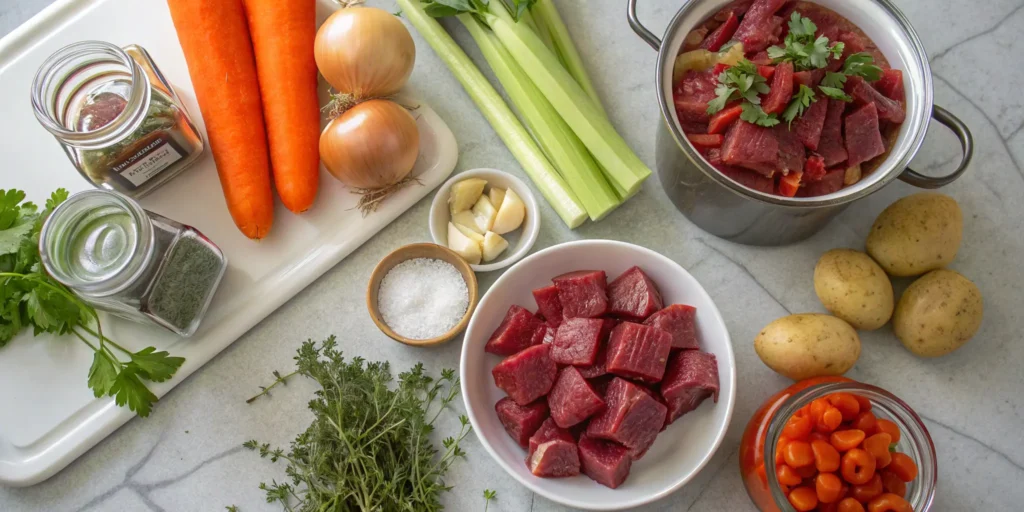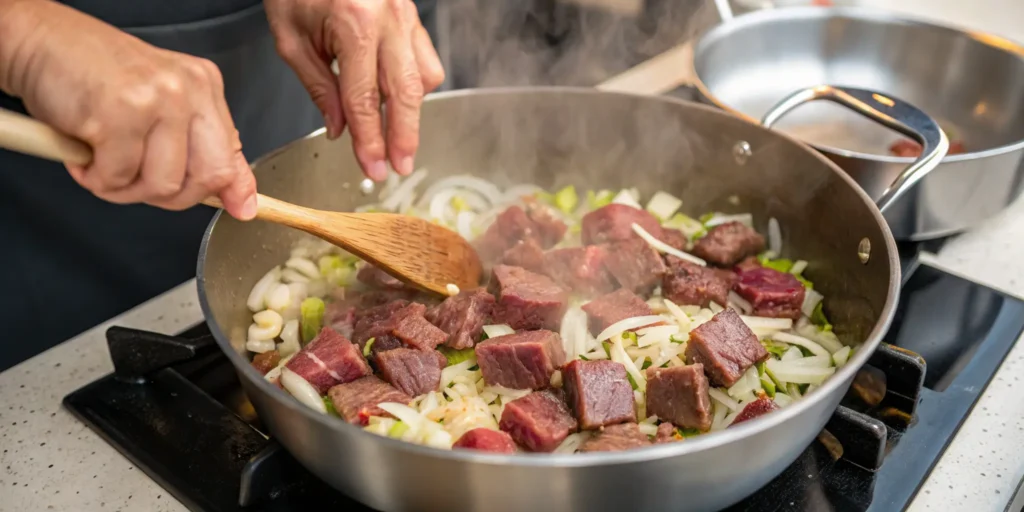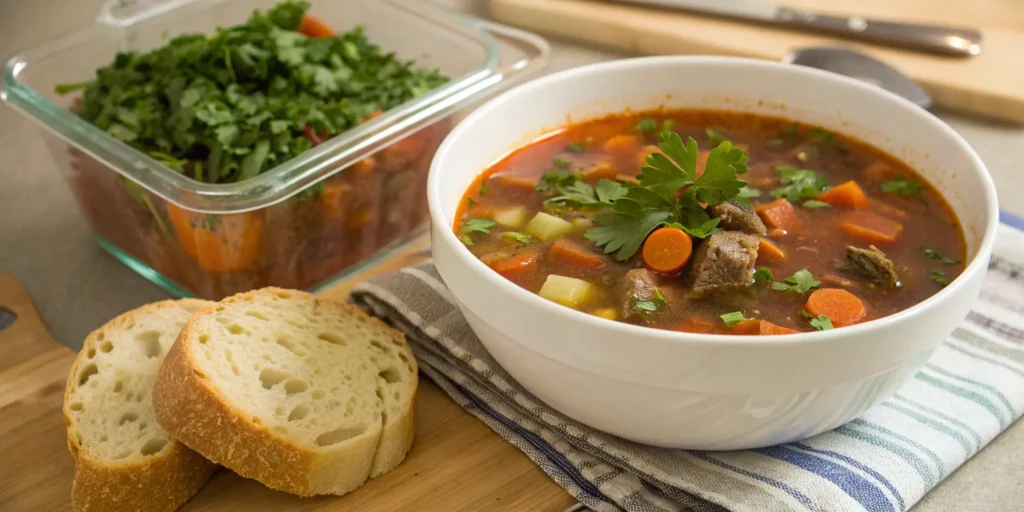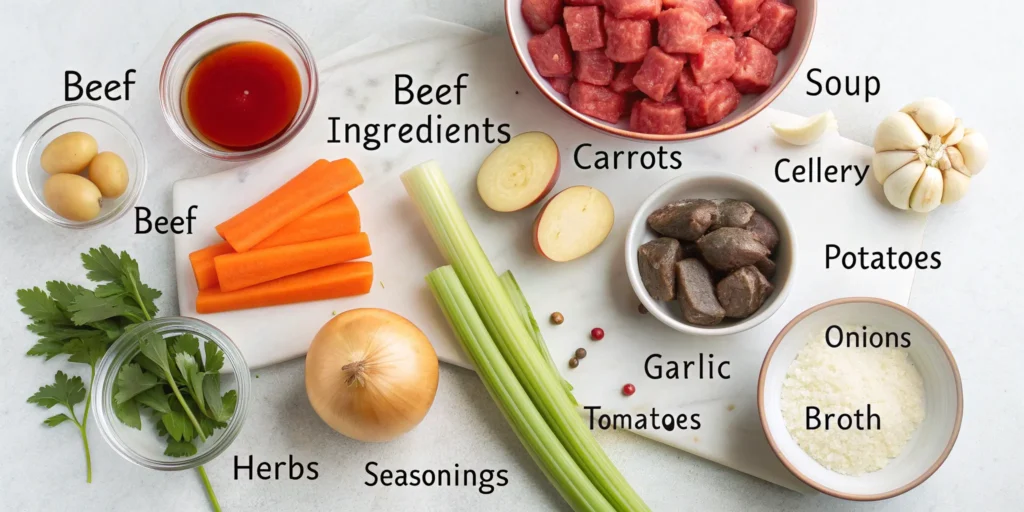Vegetable Beef Soup: 3 Easy Steps to Delicious Comfort
Table of Contents
There’s something deeply satisfying about a warm bowl of vegetable beef soup. Imagine coming home after a long day, the aroma of simmering beef and fresh vegetables filling your kitchen, ready to wrap you in comfort. This isn’t just any soup—it’s a timeless recipe that brings together wholesome ingredients and simple techniques to create a meal that nurtures both body and soul. If you’ve ever wished for an easy way to make a hearty, nutritious vegetable beef soup at home, you’re in the right place. Let me guide you through three straightforward steps to craft this delicious comfort food with confidence and ease.
Why Vegetable Beef Soup Is the Ultimate Comfort Food
When life feels hectic or the weather turns chilly, a hot bowl of vegetable beef soup can feel like a warm hug. But this soup is more than just comfort—it’s a powerhouse of nutrition. Beef provides the protein you need to feel full and energized, while the vegetables bring in vitamins, minerals, and fiber essential for your overall health. This combination makes vegetable beef soup a balanced meal, perfect for family dinners or meal prepping for the week.
Beyond nutrition, vegetable beef soup carries emotional significance for many. Perhaps it reminds you of family gatherings or moments when you were cared for through food. Making it yourself lets you tap into that nostalgia while creating new memories. Plus, the beauty of this soup lies in its flexibility—you can tailor the vegetables to what’s fresh or what you have on hand, making it a great way to reduce waste and boost flavor.
Step 1 – Choosing the Best Ingredients for Vegetable Beef Soup
Your soup’s flavor and nutrition start with the ingredients you select. Taking time to pick quality components means every spoonful will taste better and provide more nourishment.

Selecting Quality Beef for Rich Flavor
Choosing the right cut of beef is crucial. Look for stew meat or chuck roast—these cuts have enough fat and connective tissue to break down during cooking, resulting in tender, flavorful chunks. Avoid leaner cuts like sirloin for this recipe, as they can dry out during the long simmering process. If possible, opt for grass-fed or organic beef; these options tend to have better flavor and nutrient profiles. When shopping, look for beef with a rich red color and fine marbling.
Picking Fresh Vegetables for Maximum Nutrition and Taste
Vegetables are the heart of this soup. Carrots, celery, and potatoes create a classic base, but feel free to experiment with what’s in season or your favorites. Tomatoes add a subtle acidity that brightens the broth, while green beans contribute a fresh, crisp bite near the end of cooking. Choose firm, vibrant vegetables free from blemishes. If fresh isn’t available, frozen vegetables can be a reliable substitute—they’re often frozen at peak ripeness, preserving nutrients.
Herbs and spices play a subtle but important role. Bay leaves and thyme provide earthiness and depth, while fresh parsley at the end can add a burst of color and brightness.
Pantry Staples You’ll Need
Don’t forget the basics in your pantry: beef broth or stock forms the soup’s foundation. You can use homemade broth for extra richness or a high-quality store-bought version for convenience. Garlic and onions are essential aromatics that build flavor from the start. Salt and freshly ground pepper help bring out all the flavors, so use them judiciously.
Step 2 – Preparing and Cooking Your Vegetable Beef Soup
With ingredients in hand, it’s time to move into the kitchen. Cooking this soup involves a few key techniques that anyone can master.

Essential Equipment and Prep Tips
You’ll want a large, heavy-bottomed pot or Dutch oven for even heat distribution. Sharp knives and a sturdy cutting board make prep faster and safer. Before cooking, trim excess fat from your beef and cut it into bite-sized cubes. Wash and chop all vegetables uniformly to ensure even cooking.
Cooking Process Broken Down
1. Browning the Beef:
Start by heating olive oil in your pot and browning the beef in batches. This step caramelizes the meat’s surface, locking in flavor and adding a rich, savory note to your soup.
2. Sautéing Aromatics:
After removing the beef, add chopped onions and minced garlic to the pot. Cook until softened and fragrant, stirring frequently to prevent burning. This base layer deepens the soup’s complexity.
3. Adding Liquids and Vegetables:
Return the browned beef to the pot and pour in beef broth along with canned diced tomatoes. Toss in your chopped carrots, celery, and potatoes, plus bay leaves and thyme. Bring everything to a boil, then reduce to a gentle simmer.
4. Simmering:
Let the soup simmer for 1 to 1.5 hours, uncovered or partially covered. This slow cooking tenderizes the beef and allows the flavors to meld beautifully.
5. Final Touch:
Add green beans about 15 minutes before serving so they remain crisp and vibrant. Remove bay leaves before serving and taste the soup, adjusting salt and pepper as needed.
Time-Saving Tips
If you’re pressed for time, consider using a pressure cooker to reduce cooking to under an hour without sacrificing tenderness. A slow cooker is also an excellent option—just layer your ingredients and let it work its magic throughout the day. To save prep time, you can chop vegetables the night before or use pre-cut frozen veggies. These shortcuts keep your soup easy and approachable.
Step 3 – Serving and Storing Your Vegetable Beef Soup
You’ve cooked your soup—now let’s talk about enjoying and preserving it.

Perfect Serving Suggestions
Vegetable beef soup pairs wonderfully with rustic bread, crusty rolls, or a simple green salad. For an extra touch of indulgence, garnish your bowl with freshly chopped parsley, a sprinkle of Parmesan cheese, or a dollop of sour cream. These additions add texture and elevate the experience.
Storing and Reheating Tips
This soup keeps well in your refrigerator for 3 to 4 days. Use airtight containers to maintain freshness. For longer storage, freeze in portioned containers. When reheating, do so gently on the stovetop or in the microwave to avoid overcooking the beef or vegetables. Stir occasionally and add a splash of broth or water if it looks too thick.
Vegetable Beef Soup Recipe: Ingredients and Instructions

| Ingredients | Quantity |
|---|---|
| Beef stew meat (chuck) | 1.5 pounds |
| Carrots | 3 large, chopped |
| Celery stalks | 2, chopped |
| Potatoes | 2 medium, diced |
| Onion | 1 large, chopped |
| Garlic cloves | 3, minced |
| Canned diced tomatoes | 1 can (14.5 oz) |
| Beef broth | 6 cups |
| Green beans | 1 cup, trimmed |
| Olive oil | 2 tbsp |
| Bay leaves | 2 |
| Thyme (dried or fresh) | 1 tsp or 2 sprigs |
| Salt and pepper | To taste |
Instructions:
- Heat olive oil in a large pot over medium-high heat. Brown beef cubes in batches until all sides are golden. Remove beef and set aside.
- Add onions and garlic to the pot; sauté until translucent and fragrant.
- Return beef to pot. Add beef broth, diced tomatoes, bay leaves, thyme, carrots, celery, and potatoes. Bring to a boil, then reduce heat and simmer uncovered for 1 to 1.5 hours.
- Add green beans 15 minutes before the end of cooking.
- Remove bay leaves, season with salt and pepper to taste, and serve hot.
Frequently Asked Questions About Vegetable Beef Soup
What makes vegetable beef soup healthy?
You’re getting a balanced combination of protein, vitamins, and fiber all in one bowl. The beef supplies essential amino acids for muscle repair and energy, while vegetables provide antioxidants and nutrients that support your immune system.
Can I make vegetable beef soup in a slow cooker?
Absolutely. Simply brown the beef first (optional), then combine all ingredients in your slow cooker. Cook on low for 7-8 hours or on high for 4-5 hours. Add green beans in the last 30 minutes.
How long does vegetable beef soup last in the fridge?
Stored properly in airtight containers, it stays fresh for up to 4 days. If you freeze it, the soup can last for 2-3 months without significant loss of flavor.
Can I substitute beef with other proteins?
Yes, chicken or turkey work well, though cooking times may vary. For a vegetarian option, omit beef and use vegetable broth, adding beans or lentils for protein.
What vegetables can I add or omit?
Feel free to customize based on your preferences or what’s available. Zucchini, corn, peas, or spinach can be great additions or substitutes.
Making your own vegetable beef soup doesn’t have to be complicated. With just three clear steps—choosing quality ingredients, following simple cooking techniques, and storing properly—you can enjoy a nourishing, flavorful meal any time you want. This recipe not only feeds your body but also comforts your soul, providing a sense of warmth and satisfaction that’s hard to beat.
Now it’s your turn. Gather your ingredients, follow these steps, and enjoy the rewarding process of creating a classic vegetable beef soup that’s sure to become a favorite in your kitchen. Don’t forget to share your soup stories or questions below—I’d love to hear how your soup turns out!
Ready to dive in? Bookmark this recipe, subscribe for more wholesome comfort food ideas, and share this article with friends who could use a little cozy in their lives. Your next delicious meal is just a simmer away.

